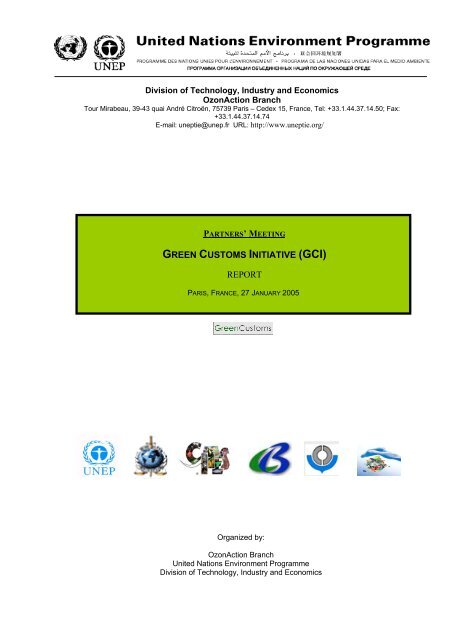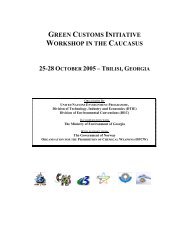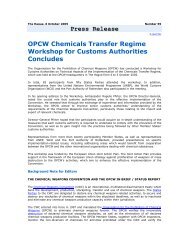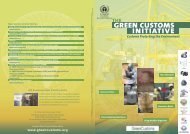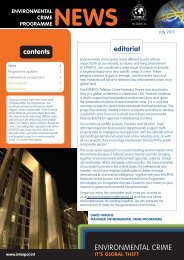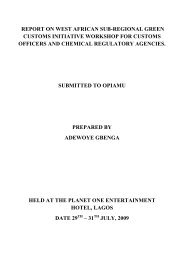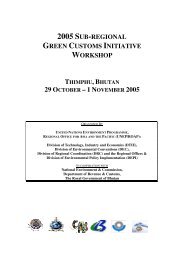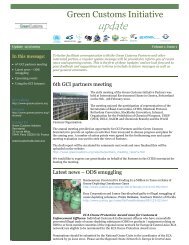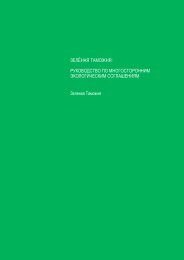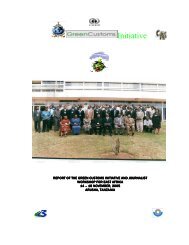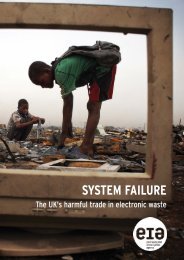Paris - Green Customs Initiative
Paris - Green Customs Initiative
Paris - Green Customs Initiative
- No tags were found...
You also want an ePaper? Increase the reach of your titles
YUMPU automatically turns print PDFs into web optimized ePapers that Google loves.
Division of Technology, Industry and EconomicsOzonAction BranchTour Mirabeau, 39-43 quai André Citroën, 75739 <strong>Paris</strong> – Cedex 15, France, Tel: +33.1.44.37.14.50; Fax:+33.1.44.37.14.74E-mail: uneptie@unep.fr URL: http://www.uneptie.org/PARTNERS’ MEETINGGREEN CUSTOMS INITIATIVE (GCI)REPORTPARIS, FRANCE, 27 JANUARY 2005Organized by:OzonAction BranchUnited Nations Environment ProgrammeDivision of Technology, Industry and Economics
Meeting Report, 27 January 2005TABLE OF CONTENTSA. INTRODUCTION.....................................................................................................2I. Welcome by Monique Barbut...................................................................................................................... 2II. Rajendra Shende’s Presentation............................................................................................................... 2B. PRESENTATIONS BY PARTICIPANTS ................................................................2I. Presentations of Partners to the <strong>Green</strong><strong>Customs</strong> <strong>Initiative</strong>.................................................................. 2II. Introduction of Invited Observers............................................................................................................. 5C. DISCUSSIONS & RECOMMENDATIONS..............................................................8I. Main Points Discussed ................................................................................................................................. 81. Training Courses ......................................................................................................................................... 8a) Modalities of the Training....................................................................................................................... 8b) Possible opportunities for Add-on GCI training................................................................................... 92. Training Manual......................................................................................................................................... 103. Judges – Prosecutors Training................................................................................................................ 114. Co-ordination - Fundraising ..................................................................................................................... 115. Information and Communication ............................................................................................................. 11II. Agreed Actions ............................................................................................................................................ 121. Training Courses ....................................................................................................................................... 122. Training Manual......................................................................................................................................... 133. Judges – Prosecutors Training................................................................................................................ 134. Co-ordination - Fundraising ..................................................................................................................... 145. Information and Communication ............................................................................................................. 14D: ANNEXES.............................................................................................................15Annex I: .............................................................................................................................................................. 15Annex II............................................................................................................................................................... 171
A. INTRODUCTIONMeeting Report, 27 January 2005UNEP hosted in its office a meeting of the Partners to the <strong>Green</strong> <strong>Customs</strong> <strong>Initiative</strong>(GCI) on 27 January 2005. The purpose of the meeting was to review the status ofthe GCI, review the role and contribution of each partner, plan the next steps, andintroduce new partners (designated as “observers) who might be considered foraddition to the group.I. WELCOME BY MONIQUE BARBUTDTIE Director Ms Monique Barbut welcomed and thanked the participants. Sheemphasised the uniqueness of this first effective practical project collaborationbetween these chemical conventions whose fundamental issues are applicable toconventions like the Convention in International Trade in Endangered Species ofWild Fauna and Flora (CITES) as well. She underlined the importance of combatingillegal trade through the co-ordination of the environmentally-related customsactivities and through strong penalties for illegal traders and smugglers.Furthermore she thanked the participants for committing resources of various kindsto help the <strong>Green</strong> <strong>Customs</strong> <strong>Initiative</strong> take off. Ms Barbut particularly thanked theGovernment of Norway for providing financial input and also announced that UNEP’sDivision of Environmental Policy Implementation (DEPI) and the Government of theCzech Republic would provide funds for several training workshops.Finally, she highlighted that it is essential to involve the whole chain of enforcementofficers to make training against illegal trade most effective. She enhanced the needto build the capacity especially of judges and prosecutors to fully implementmultilateral environmental agreements (MEAs) in close co-ordination with customsadministrations.II. RAJENDRA SHENDE’S PRESENTATIONThe Head of the DTIE OzonAction Branch, Rajendra Shende, gave an overview ofactivities and achievements of the GCI for the period 2002 until 2004. He highlightedthat with relatively small resources provided by the Division of EnvironmentalConventions (DEC), the initiative not only took roots, but could carry the activities tobuild the blocks for the coming years. He outlined the objectives and expectedoutcomes of the meeting. He emphasised the need of strengthening the enforcementand compliance chain, focusing on capacity building for prosecutors and judges inthe <strong>Green</strong> <strong>Customs</strong> <strong>Initiative</strong>. The need for a common resource mobilisation strategyand a common communication and information approach as well as the possibleexpansion of the partnership was stressed.B. PRESENTATIONS BY PARTICIPANTSI. PRESENTATIONS OF PARTNERS TO THE GREENCUSTOMS INITIATIVETo open the meeting, the participants provided input and background on the statusof the initiative within their area of expertise, focussing on highlights of activities,challenges and barriers since the first Partners meeting in October 2001.2
Meeting Report, 27 January 2005The presentations were provided by (in order of their presentation):• Mr. Stephen Nash, Chief of Unit, Capacity Building, Secretariat of CITES• Mr. Carl Bruch, Legal Officer, UNEP DEPI• Ms. Donata Rugarabamu, Senior Legal Officer, Secretariat of the BaselConvention• Mr. Gilbert Bankobeza, Senior Legal Officer, UNEP – Ozone Secretariat• Mr. Mark Measer, Crime Intelligence Officer, Secretariat General Interpol• Ms. Laura Meszaros, Rotterdam Convention• Mr. Suresh Raj, Capacity Building Manager, OzoneAction BranchMs. Anette Bonde, technical Officer, WCO, had sent a written statement prior to themeeting.Dr. Gilbert Bankobeza from the Ozone Secretariat moderated the session.‣ CITESStephen Nash presented the CITES’ view on illegal trade and customs. He remindedthat CITES focuses primarily on regulating legal trade, rather than combating illegaltrade. Within CITES training sessions, customs officers only amount to 5% of theaudience. To reflect this, CITES decided to use their training budget to aim at selfinstructiontraining. In this context Mr Nash presented CITES’ interactive CD-ROMon customs training.He also emphasised the need to increase dialogue between customs officers andnational Management/Scientific Authorities, as those are the specialists the customsofficers should contact in case of any uncertainties.One of the challenges for combining CITES customs activities with other MEAs isthat for wildlife the illegal trade by majority takes place by air, whereas illegal trade inchemicals or hazardous waste is conducted mostly by land or sea.Finally he pointed out, that the priority in his view for the <strong>Green</strong> <strong>Customs</strong> documentswould be awareness raising of customs officers, rather than a detailed trainingprogramme.‣ DEPICarl Bruch gave some background information on how DEPI came to this initiative.He mentioned the Guidelines adopted in 2002 by the UNEP Governing Council.Those guidelines set out various tools to increase compliance with and enforcementof MEAs. Expanding on these guidelines, DEPI has developed a Manual incollaboration with many of the Secretariats and other participants through a processof regional capacity building workshops. This Manual expands upon the variousapproaches set forth in the Guidelines, including ways to enhance capacity andeffectiveness of customs officers. Mr. Bruch also reviewed the pilot activities thatDEPI is undertaking and supporting to improve implementation of MEAs, such as itssupport for the <strong>Green</strong> <strong>Customs</strong> <strong>Initiative</strong>.Carl Bruch also mentioned that Vijay Samnotra from the UNEP Division ofEnvironmental Conventions (DEC) regretted he could not join the meeting today, butremains interested in this <strong>Initiative</strong>.3
‣ Basel ConventionMeeting Report, 27 January 2005Donata Rugarabamu gave background information and an update about past andplanned activities. Last year the Basel secretariat signed an MoU with theOrganisation for the Prohibition of Chemical Weapons (OPCW); thus the twoorganisations now collaborate at the institutional level. Ms Rugarabamu gavebackground information on the 7 th Conference of the Parties (COP), which took placein Geneva, 25-27 October 2004. For the future, the Basel Secretariat hopes todevelop long-term projects and legislation together with MEAs covering chemicalsand other partners. She also mentioned, that the Basel Secretariat hopes to conducta regional meeting in Panama, where the GCI training manual could perhaps betested.The Basel Convention has 14 regional centres to deliver training at the regionallevel.As moderator of the session, Dr. Bankobeza underlined that resources could bepooled by several MEAs to enable such regional workshops to happen.‣ Ozone SecretariatGilbert Bankobeza presented highlights of activities conducted and challenges metby the Ozone Secretariat. He noted that UNEP DTIE is the implementing arm forcustoms training in the Montreal Protocol, thus explaining the role of DTIE within the<strong>Green</strong> <strong>Customs</strong> <strong>Initiative</strong>.A major challenge for Parties to the Montreal Protocol, are the continuing activities inillegal trade in ODS which is encouraged because the prices of ODS have remainedlow compared to the cost of ODS alternatives.Furthermore he was concerned about very low reporting of cases of illegal trade bythe Parties compared to what is mentioned in the media. As per a MOP decision,Parties are requested to report such cases to the Ozone Secretariat. However, henoted that some countries such as the Unites States have undertaken impressiveefforts in catching smugglers.He also acknowledged the difficulty in achieving sustainability of customs trainingand that it is difficult to make sure, that information delivered through the training intrickling down to the whole structure.‣ InterpolMark Measer provided the presentation of Interpol’s activities and views on the<strong>Green</strong> <strong>Customs</strong> <strong>Initiative</strong>. He is one of the two individuals at Interpol responsible forenvironmental pollution and crimes. Mark Measer is in charge of pollution crimes.Up to now, Interpol offers environmental crime train-the-trainers programmes. Thesetrainings take 4 days and police officers, prosecutors and judges from differentcountries are invited to take part. The participants then go back to their home countryand teach their colleagues. The teaching back in the trainees’ home countries istaking place rather informally.For the future, one main goal in capacity building is to achieve collaboration andinformation sharing between nations. Inter alia, Interpol aims at developing a cleanseas programme with focus on combating oil pollution from vessels.‣ Rotterdam ConventionLaura Meszaros gave a quick overview about ongoing developments under theRotterdam Convention. Up to now, no training for customs officers is provided. The4
Meeting Report, 27 January 2005Rotterdam Convention Secretariat wishes to look at possible synergies with the otherconventions and learn more about the status of the GCI and what role theSecretariat could play.Ms. Meszaros also conveyed that Elena Sabokina (from the Stockholm ConventionSecretariat) had been unable to join the meeting as she was on sick leave.‣ UNEP DTIESuresh Raj gave a review of ongoing proceedings at the Montreal Protocol customstrainings, as DTIE is the lead agency in this implementation sector.First of all, a total amount of 5 million dollars, funded through the Multilateral Fund,GEF and bilaterals, has been provided to this programme.In general, UNEP follows a two-phase customs training approach using the train-thetrainermethodology. Phase-I training is conducted by UNEP, followed up by nationalPhase-II workshop(s) organised by the country itself.Before the training is conducted it is also considered essential to make sure that theright national legislation is in place (it is a requirement before the Montreal Protocolworkshop can take place that Licensing systems are approved by the country).In order to raise international awareness about the GCI, UNEP presented the GCIconceptat, inter alia, internal meetings of the World <strong>Customs</strong> Organisation (WCO), aworkshop of the Basel Convention held in Romania and at the MOP, with greatresponse from the respective participants. UNEP along with the partners alsoprepared some fact sheets that can be accessed from the web site. For the future amore intense outreach to public media should be envisaged.For the Montreal Protocol involving other partners is one of the key challenges, it isvery important but at the same time it is sometimes difficult, as the cross-cuttingissues are not always at the top of the MEAs agenda.The WCO also provided a written statement describing their action regarding theGCI and possible further involvement.II. INTRODUCTION OF INVITED OBSERVERSFollowing the presentations of each partner and the discussions afterwards, theintroduction of the invited observers took place. Each observer presented its mostrecent activities in relation to illegal trade and customs training as well as their viewson the GCI.The invited observers were (in order of their presentations):• Ms. Magda Bauta Solés, Head, Implementation Support Branch, InternationalCo-operation and Assistance Division, Organisation for the Prohibition ofChemical Weapons (OPCW)• Ms. Angela Bularga/Krzysztof Michalak, Non-Member Country Division,Environment Directorate, Organisation for Economic Co-operation andDevelopment (OECD)• Ms. Margaret McCauley, UNEP Desk Officer, U.S. State Department• Mr. Ken Markowitz, International Network for Environment Compliance andEnforcement (INECE) Secretariat• Mr. Asad Naqvi, Programme Officer, Economics and Trade Branch, DTIE• Ms Linn Persson, Research Associate & Project Manager, Ozone LayerProgramme, Stockholm Environment Institute (SEI)• Mr. Trond Grongstad, Ministry of Foreign Affairs, Norway5
Meeting Report, 27 January 2005• Mr. Bruce Pasfield, Assistant Section Chief, Environment Crimes Section, USDepartment of Justice‣ OPCWMagda Bauta introduced OPCW’s activities and explained the tracking system ofchemical weapons implemented by OPCW, controlling imports and exports ofdangerous chemicals. OPCW has also recognised the necessity of adoptingappropriate legal trade regulation.OPCW has customs training programmes but finds it difficult to reach out to theconstituencies of customs and they would like to cooperate with UNEP DTIE whichspecifically works with customs officers. OPCW invited UNEP DTIE to participate inone of its technical meetings in Buenos Aires on 6-8 September 2004.A framework MOU between UNEP and OPCW is in progress (draft needs to beapproved by the Executive Council of the OPCW). Ms Bauta emphasised thenecessity of securing that this initiative is properly funded. OPCW itself isconsidering to commit some financial resources to the GCI.‣ OECDAngela Bularga presented the OECD work on environmental compliance assurancethat focuses mostly on non-member countries, in particular on environmentalinspectorates and their partners from Eastern Europe and Central Asia. Thisprogramme area aims at raising effectiveness and efficiency of environmentalenforcement authorities, and achieving higher regulatory compliance.Among others, capacity building activities for environmental inspectors areimplemented. These included the development of a “Glossary of EnvironmentalCompliance and Enforcement Terms” initially intended for environmental inspectors,but also distributed to other parties like NGOs, prosecutors and judges, etc.Recently, a “Toolkit for Environmental Inspectors” was published, which Ms Bulargaoffered to forward to the Partners is case of interest. Based on the Toolkit, trainingworkshops were conducted in Caucasus (with participation of inspectors fromArmenia, Azerbaijan and Georgia), Kazakhstan, and Russian Federation. The nexttraining is planned to happen in Kyrgyzstan in February 2005.The OECD representative underlined the need to create a sustainable mechanism oftraining, giving as example one especially successful project in Kazakhstan, wherethe training programme for inspectorates is delivered by a self-financing independenttraining centre.Ms Bularga also mentioned the EECCA Regulatory Environmental ProgrammeImplementation Network as a possible avenue for conveying the messages of theGCI.‣ INECEKen Markowitz explained that INECE is a partnership of prosecutors, civil lawyers,judges and parliamentarians and others, rather than an NGO. Its main aim is tofacilitate communication between different stakeholders and help organisations inthe area of environmental compliance and enforcement.INECE strikes for three main goals to combat illegal trade: awareness raising,building capacity and especially promoting networks. Mr. Markowitz highlighted theneed of raising awareness regarding the compliance with the rules of law to achievea mindset within the judiciary responsive to issues of international criminalenvironmental law. INECE’s web site includes links to specific MEAs and literature6
Meeting Report, 27 January 2005on compliance and enforcement. It also keeps a very active calendar on upcomingmeetings and other activities.Regarding capacity building INECE acknowledges the need to apply pressure at theright points in the enforcement chain. If 100% of illegal trade in ODS would bedetected and only 5% prosecuted, enough incentive for enforcement might not bethere. Within the judicial training one should focus on reaching a commonunderstanding of these themes around the world.INECE offers a “Principle of Environmental Enforcement”-course including text andtraining exercises in the areas of development of legislation and implementation.Mr. Markowitz informed the Partners of INECE’s triennial workshop taking place 9-15April 2005 in Marrakech and invited them to join the meeting. More than 200practitioners will participate.‣ US State DepartmentMs. McCauley expressed satisfaction on behalf of the State Department to see theinvolvement of US authorities on this subject. She emphasised the possible risk ofillegal trade developing in the field of MEAs having recently entered into force, suchas Rotterdam or Stockholm. She highlighted the experience of the US working withCanada and Mexico under the North American Free Trade Agreement (NAFTA) toensure that customs and enforcement officers are aware of the stakes of MEArelatedillegal trade. She mentioned the possibility of US funding for this initiative inupcoming months and years. Finally she stressed the importance of developingsupport groups and networks to follow-up on the training workshops.‣ DTIE ETBMr. Naqvi offered ETB’s view on ways of combating illegal trade from the experienceof the joint UNEP-UNCTAD Capacity Building Task Force (CBTF).Mr. Naqvi gave examples of successful approaches in CBTF, such as: learning-bydoingapproaches for training, focus on economic instruments as means ofimplementation, accountability-building at the national level, creation of networks andinclusion of principles in national educational programmes.One of their main concerns is to think from the recipient’s end. In this areaassessment is needed, as the supply of information should be precisely targeted.Methodological issues should be defined, such as: how to build balance betweenvarious types of training; what instruments are the most useful and effective ones.For the future a link up of the GCI with the WTO should be considered.‣ Stockholm Environment Institute (SEI)Linn Persson introduced the work of SEI. SEI is an international environmentalinstitute specialising in sustainable development and environment policy issues.Within their Atmospheric Environment Programme, SEI deals with emissions of ODSand persistent organic pollutants (POPs). SEI identified the need for collaboratingwith customs officers and thus created a network of ozone officers in Southeast Asiaand Pacific with participation of 22 countries, which is operated by UNEP from theRegional Office for Asia and Pacific. Meetings take place twice a year. SEI focusesnot on front line officers but on customs officers from higher authorities. Theparticipating countries gave positive acknowledgement to this approach. In the futureit will be discussed how this could be done in a broader scope, which could berelevant for other MEAs as well.7
‣ Norway (Ministry of Foreign Affairs)Meeting Report, 27 January 2005Trond Grongstad expressed his support to the initiative on behalf of the Governmentof Norway. <strong>Green</strong> <strong>Customs</strong> is considered a very important initiative as it strengthensnational implementation of MEAs and makes MEAs work together through a practicalapproach. Mr. Grongstad mentioned that the support from Norway was coming fromthe ODA budget and that discussions were being held with UNEP for 2005contributions, but that it was still to early for any further commitment. He emphasisedthe priority areas of Norway, among other things in: assistance to Africa; andcapacity building for MEA enforcement.C. DISCUSSIONS & RECOMMENDATIONSThe meeting did not formally agree to adopt conclusions. However, the following is asummary of the key messages from the participants and their approval on follow-upactivities to be conducted by the partners/participants.The participants agreed that following an integrated approach is the most importantmatter. A workplan of activities for the GCI was developed. This includes fiveprioritised items:1. Training Courses – dedicated Add-on to meetings/workshops planned byparticipants2. Training Manual3. Co-ordinating – Fundraising – Networking and ensuring sustainability ofthe initiative4. Judges – Prosecutors – Training, postponed to 20065. Information and CommunicationI. MAIN POINTS DISCUSSED1. Training Coursesa) Modalities of the Training• Training approach: DTIE OzonAction Branch suggested following the train-thetrainersapproach, as UNEP have found this method to be successful in relationto Montreal Protocol training.The CITES Secretariat recommended training experts to become better trainers,rather than to train laymen to actually become trainers. From their experienceexpert knowledge is essential, as customs officers address the trainers withspecific questions that need to be answered on the spot.• Trainers: One of the questions raised was whether one trainer could adequatelydeliver training related to several MEAs. Participants recognised that specialistswell versed in the details of each of the Conventions should be present, to beable to respond to specialised questions.The Basel Convention Secretariat addressed the importance of including focalpoints in customs training to increase effectiveness.In the view of the CITES Secretariat, their focal points do not know well thecustoms’ issues so they would prefer a competent customs officer to do thetraining.8
Meeting Report, 27 January 2005Furthermore it was considered, that one convention could do the training and theothers participate with various sorts of contribution and commitment from otherpartners.• Regional versus national training: Advantages of national level could be that itis easier to test the manual for the first step of training. On the national level, onecan also be more country-specific, i.e. provide detailed training also on nationallegislation. Furthermore, it secures that the training reaches the in-countryofficials and it prevents from conducting an extensive and difficult follow-up,necessary when doing regional training.However, one reaches more countries with just one training event if it isconducted on the regional level. Widespread knowledge due to training could beachieved faster and at a lower cost.• Needs assessment: To make sure that the training is effective, it needs to bedemand-driven. One has to have a close look on the target countries; i.e. whatlegislation do they have in place, in which area does illegal trade appear mostly intheir country and which is the level of interest of customs officials and otherrelevant stakeholders.• Sustainability: One issue is customs staff turnover. Not only do people move onover time but also the issues evolve over the years. MEAs with Amendments andAppendices that get amended regularly are intensely affected by that. Thesealterations fundamentally change what customs officers are expected to do. Thusit is very difficult to keep front line customs officers up-to-date. Possible solutionsmay be distribution of newsletters, conduct repeated training, offer a regularly updatedweb site and in general, try to get out as much information as possible. Toachieve effective and widespread sustainability one should be able to rely on incountryrepresentatives. Thus it is important to involve the national institutions toinclude <strong>Green</strong> <strong>Customs</strong> related training in their training curricula.b) Possible opportunities for Add-on GCI trainingIn this session, the participants discussed the possibility of introducing the GCI ondifferent occasions and possibly testing the Draft Manual at some meetings.Please find below the schedule of upcoming meetings and what might be done:• Ozone Secretariat, Workshop on Illegal Trade, 2 April 2005 (tentative date)This will be an expert meeting held by the Ozone Secretariat on illegal trade. Theorganisation of this meeting was initiated by a MOP decision that suggesteddeveloping a tracking system for illegal trade.• INECE Conference, 14 April 2005INECE holds a Conference in Marrakech from 9-15 April 2005. Mr Markowitzinvited all participants to attend the meeting. He suggested using one of theworkshop sessions to vet the Draft <strong>Customs</strong> Training Manual. A shortpresentation and then gaining some feedback should be intended.• SIDA & ROAP, 25-27 April 2005The Swedish International Development and Co-operation Agency (SIDA) andthe UNEP’s Regional Office, Asia and Pacific (ROAP) will hold a meeting at theend of April for customs officers on ozone (Regional Network). 22 countries ofSouth East Asia will participate in this networking customs and ozone trainingworkshop. The format for introducing the GCI at this event should be discussedat the regional level.9
Meeting Report, 27 January 2005• DEPI & ROWA, 2-6 May 2005DEPI will organise a meeting on compliance and enforcement in Beirut in cooperationwith the help of the Lebanese Government and UNEP’s RegionalOffice of West Asia (ROWA). This is part of the series of workshops on DEPI’sMEA Compliance and Enforcement Manual. There would be a possibility forinviting additional customs officers and organise parallel and specific customssessions at the meeting.• Interpol, 2-3 June 2005Interpol will organise a meeting in Lyon and offered to provide a presentation onthe <strong>Green</strong> <strong>Customs</strong> <strong>Initiative</strong>. Representatives of Interpol’s National Bureaus fromeach country will participate.• Easter Europe, Caucasus and Central Asia’s Regulatory EnvironmentalProgramme Implementation Network (REPIN), first week of October 2005This meeting, organised by the OECD, brings together policy and enforcementofficials from Eastern Europe, Caucasus and Central Asia as well as OECDcountries. It will be held in Tashkent, Uzbekistan. The OECD offered to use theNetwork to disseminate information and collect feedback about the GCI andvarious activities planned under its umbrella in the EECCA region.• OPCW, October 2005OPCW intends to hold a meeting of officials at the decision-making level inOctober, discussing the requirements of CWC on implementation in terms ofimports and exports. The presence of observers would be welcomed.2. Training Manual• Raising awareness versus detailed training: It was suggested that raisingawareness should only be the first step to target. Further, drafting a manual thatis dealing with all MEAs in a detailed way did not seem to be feasible in the shortterm. It would be too voluminous and would double work already done by thoseSecretariats that already have training material in place.Everyone agreed that two aims should be having customs officers know whom toask when questions arise and providing them with tool kits to act on issuesrelated to MEAs.• Level of previous knowledge of trainees: This needs to be assessed. Mr.Naqvi argued that we do not start the training from scratch. Trainees could befrustrated when confronted with basic information.• Language of training material: The Basel Secretariat explained that theyalways provide their training material in six different languages as stipulated bythe Parties.At least it should be provided initially in three different languages, English, Frenchand Spanish.• Toolboxes: Development of training “toolboxes” was suggested. The advantageof a toolbox would be that it could be modified according to the needs ofcountries participating in the training.• Addressee of the Manual: The draft outline circulated was primarily meant toaddress trainees. Specific materials for the trainers should also be adopted.10
Meeting Report, 27 January 2005• Print version or electronic version: The CITES Secretariat consciouslyavoided a paperwork training manual for customs officers, they have theirelectronic self-instructive CD-ROM and would like to leave it at that. The OPCWSecretariat mentioned they have had good experiences with electronic tools aswell.On the other hand not all customs officers have access to computers or are usedto working with them, especially in developing countries.• Additional Information: The Basel Secretariat suggested to include in thecustoms training manual the information prosecutors and judges might requirefrom the customs officers. It was also proposed to consider training of legislatorsand members of parliament in the long run.3. Judges – Prosecutors TrainingDTIE raised the issue of including training for judges and prosecutors, as it isessential to ensure that the whole enforcement chain works together to effectivelycombat illegal trade. There was a general appreciation of the idea of implementing atraining programme for judges and prosecutors as a component of the <strong>Green</strong><strong>Customs</strong> <strong>Initiative</strong>.Participants recognised the fact that integrating other members of enforcement chainwould be beneficial as well. Mr. Pasfield pointed out, that especially investigatorsand prosecutors should hear each other and in particular the other’s approach indealing with a criminal case. Mark Measer from Interpol supported this “team-workapproach” and emphasised that network building is the most important issue toeffectively fight traffickers. He suggested developing or using a real crime scenarioand discussing this together within training sessions.OPCW emphasised the need to reach people who draft legislation. A key aspectwithin the enforcement chain is having the proper legislation. To achieve this,training should also reach out to the parliamentarians, as they have to approve thedrafted legislation. In the past OPCW has trained and invested in this and would behappy to share these programmes.4. Co-ordination - FundraisingTo secure sustained funding for co-ordination of the <strong>Initiative</strong> will facilitate thedelivery of the expected outcomes, e.g. co-ordinate workshops, exchanginginformation, enabling easy access to regularly up-dated information, co-ordinatedistribution of outreach material.5. Information and CommunicationJim Curlin, OzonAction’s Information Manger, gave a presentation on informationand communication (I&C) within the GCI.Mr Curlin presented DTIE’s understanding of the I&C needs of the initiative: Informthe wider world about the initiative, Attract additional support (political, financial, inkind),Deliver and/or reinforce training, Avoid duplication, and to Maintain a commonknowledge base. He suggested the means by which these needs could be met:Branding (develop an easily-recognised identity for initiative e.g. logo, slogan), Web11
Meeting Report, 27 January 2005activities (provide regularly-updated information about the initiative, deliver on-linetraining), Outreach materials (spread common messages & information e.g. abrochure, progress report), Media interaction (engage press & invite them to trainingevents), Internal actions (promote internal understanding e.g. internal briefings,inform directors), Events (conduct special GCI outreach at COPs/MOPs, e.g.roundtables, exhibits).He presented several existing UNEP DTIE information services that were alreadybeing marketed with the GCI “brand”, including the <strong>Green</strong> <strong>Customs</strong> provisional logo.These items were: <strong>Green</strong> <strong>Customs</strong> website (www.uneptie.org/ozonaction/customs/),Trade Names database (www.uneptie.org/ozonaction/library/tradenames/main.asp),Nothing to Declare customs training video(www.uneptie.org/ozonaction/library/video/customs.html) He also presented a quickoverview of the <strong>Green</strong> <strong>Customs</strong> website, launched in June 2003.The main issues raised during the discussion were:• Work arrangements for GCI I&C issues.• The need for GCI to have a common I&C plan (including objectives, targets,messages, and resources) was discussed.• The need for common outreach materials was identified as a priority, even inthe form of a brochure or presentation.• Web site. The website should be the repository for the <strong>Initiative</strong>. It will be to(a) host information about the GCI initiative itself that does not exist anywhereelse (b) provide a short overview of each Partner’s activities related to <strong>Green</strong><strong>Customs</strong> (c) link to existing online resources on the Partners’ web sites (i.e.not reproduce or house information already on the Partners’ websites). ThePartners should be the masters of the website content related to theirorganisation. All relevant Partner events should be listed on the GCI site.II. AGREED ACTIONS1. Training CoursesTo begin with there was a general understanding that the first few training coursesconducted will be partly capacity building and partly vetting of the Manual. See belowfor details the meeting agreed on.• Regional or national training: In the end participants agreed on following thesubregional/regional training approach, as seems most important to reach asmany countries and customs officers as possible and as soon as possible, inconsideration of a limited budget.• funding and conducting workshops:• DEPI offered funding for 5 regional courses with an approved budget of$100,000. Requests already put forward came from:- South Asia- East Africa- West Asia- Caucasus- Latin AmericaThe Czech Republic has also committed funding a training workshop inCentral Asia. The OECD is interested to co-operate on training workshops in12
Meeting Report, 27 January 2005Eastern Europe, Caucasus and Central Asia. To use the funds of DEPI theseworkshops need to be carried out before October 2005.• Basel offered to contribute resources for the organisation of the workshops,for example through its regional offices. The Basel Convention particularlyemphasised that a workshop they had planned in Panama had to bepostponed due to lack of funding and that there was a potential synergy withthe GCI for a workshop there.• CITES offered to contribute training materials for distribution.• DTIE OzonAction could support the <strong>Initiative</strong> with 2 staff members.• Interpol can offer the help of staff through the Secretariat or from its regionalbureaus.• The funds from Norway can also support these training workshops.• OPCW is generally willing to commit funds for courses at the regional level.They have material in place and a resource person to do the CWC section.Only the MoU still needs to be approved.• It was also mentioned that the Regional Offices from the WCO (RILOS) couldbe of assistance for the organisation of the workshops.2. Training ManualFirst of all, the need for development of a working version of the manual wasascertained.• Language of training material: The first draft of the Training Manual should bein English, further translations will necessarily follow.• Awareness raising: Common understanding, that the training manual shouldfocus on awareness raising, rather than providing detailed training. However, itshould also provide customs officers with contacts and tools for them to addresstrade related to environmentally-sensitive commodities covered by MEAs. Themanual should focus on similarities between MEAs emphasising commonapproaches and techniques across MEAs.• Printed version: Participants agreed to first develop a printed version and thenconsider extending training material to electronic version, as not every customsofficer has access to a computer or is willing to study using electronic means.• Target group: the target groups (within customs authorities, and within nationalMEA contact points/authorities) still need to be precisely defined by theparticipants.• Comments: It was agreed that partners and participants provide their commentson the Draft Outline circulated by DTIE by 15 February 2005.3. Judges – Prosecutors TrainingIn general participants were in agreement regarding the necessity for specifictraining sessions for each member of the enforcement chain, but also limited jointtraining to be a key element to combat illegal trade and build a “team spirit” amongvarious enforcement officers.13
Meeting Report, 27 January 2005At the same time the partners decided unanimously that it is too early to tackle thisissue as the initial priority should be on customs training and particularly thedevelopment of the manual.Existing initiatives will be surveyed to be able to link up with whatever is currentlyexisting.4. Co-ordination - FundraisingPartners have different perception of the need for a strong coordination role. Theimportance of having dedicated staff to the coordination of the <strong>Green</strong> <strong>Customs</strong>initiative (preparation of workshops, reporting, communication between partners)was however emphasised. UNEP DTIE has played this role up to now and is readyto continue such a task, on the basis of the renewed commitment of all the partnersto this initiative.5. Information and CommunicationThe partners and participants agreed on the following concepts to be implemented:• “Focal Point”: Partners agreed to nominate focal points (e.g. informationofficers) for communication on this aspect of the Partnership. Once the focalpoints were known, UNEP DTIE would organise a teleconference of those focalpoints.• Common I&C Plan. Partners were open to the idea, but would wait for the focalpoints to be constituted before taking any decision.• Promotion: Partners would consider promoting the GCI during MOPs/COPs andother meetings as well as promote internal understanding of the initiative,especially among heads of departments and directors.• Website: Partners agreed to more regular and active contribution of informationthrough the I&C focal points. Partners should draft a GCI summary text for theirown website and link it to the GCI homepage. They should as well provideregularly updated information about GCI on their own website. Partners agreedon the choice for the GCI domain name (greencustoms.org). UNEP DTIE willpurchase the domain name and inform the Partners.• Outreach material: While recognising that there is a need for such materials, thePartners will leave it to the I&C focal points group to further study this issue.• Presence in Press: Partners should invite the press to several events (forexample training workshops) to increase public knowledge of GCI. They shouldinclude the <strong>Initiative</strong> in media information wherever possible.• Branding: The Partners accepted the logo developed by UNEP DTIE as theofficial logo of the GCI.• Presentation: Participants requested that the PowerPoint presentation on I&Cissues be circulated.14
Meeting Report, 27 January 2005D: ANNEXESANNEX I:Partners’ Meeting<strong>Green</strong> <strong>Customs</strong> <strong>Initiative</strong> (GCI)<strong>Paris</strong>, 27 January 2005United Nations Environment ProgrammeDivision of Technology, Industry and Economics - OzonAction ProgrammeProvisional Annotated AgendaThursday, 27 January 200510:00 - 10.10 WelcomeMonique Barbut, Director, UNEP DTIE10.10 - 10:20 Introduction of Participants,each participant to very briefly introduce himself/ herself10.20 – 10.30 Expectations from GCI Partners MeetingRajendra M. Shende, Head, OzonAction BranchPresentation of the main milestones to date and challenges ofthe coming year. Brief introduction of the expected outcome ofthe meeting.10:30 - 11:30 Status of the <strong>Initiative</strong> 2002-2004Each Partner will briefly present (5 minutes each)highlights ofactivities, challenges and barriers since the first Partnersmeeting in October 2001:DTIE OzonAction: Suresh RajCITES Secretariat: Steve NashUNEP DEPI: Carl BruchStockholm Convention: Elena SobakinaRotterdam Convention: Laura MeszarosBasel Convention Secretariat: Donata RugarabamuOzone Secretariat: Gilbert BankobezaInterpol: Mark MeaserWCO (invited to present by teleconference)11.30 - 11.50 Coffee break11:50 - 12:20 Introduction of the invited observersEach observer will briefly present (5 minutes each) its mostrecent activities in relation to illegal trade and customs trainingas well as their priorities for the GCI.OPCW: Magda BautaOECD: Krzysztof Michalak or Angela BulargaUnited States State Department: Margaret McCauley15
Meeting Report, 27 January 2005INECE Secretariat: Ken MarkowitzFrench <strong>Customs</strong> Administration: Sophie Meynard andEmmanuelle GalloisSweden (SEI): Linn PerssonNorway (Ministry of Foreign Affairs): Trond Grongstad12.20 – 13.00 Brainstorming on the Work PlanModerator: M Carl Bruch (invited) and Suresh RajDuring this session, participants will highlight potential elementsof a work plan of activities for the GCI. Partners will be asked tonote which activities are priorities for 2005 and which arepriorities for 2006 and beyond. Additionally, partners should notewhere they may be able to contribute resources.13:00 - 14.15 Lunch14.15 – 15:30 Summary of discussion on work plan & Discussion on financingthe <strong>Initiative</strong>Moderator: Carl Bruch and Suresh RajThis session will draw from the participants’ brainstorming andsuggestions on the proposed work plan and will agree on a planof action, including tentative dates and locations for integratedcustoms workshops in 2005 & resource kit. The funding of theseactivities will also be addressed with a focus on activities thatmay need additional resources. Options of funding sources willbe discussed.15:30 - 16:45 Coordination of specific GCI activities• GCI <strong>Customs</strong> Training ManualBruce Pasfield, US Department of JusticeThis session will present the status of the work on the <strong>Green</strong><strong>Customs</strong> Manual and the approaches followed. An annotatedoutline will be available for comments. It will aim at agreeing onthe participants’ role in providing material and feedback on thedraft manual. Partners will discuss additional resources apartfrom Manual.• Information and Communication for the GCIJim Curlin, UNEP DTIEDiscussions will focus on the information and communicationneeds of the initiative, and possible means to achieve them, withfocus on the existing web site. Issues needing resolution will beidentified.16:45 - 17:00 Conclusions and closing statementMonique Barbut, Director, UNEP DTIE17.00 Cocktail Reception at UNEP DTIE offices16
Meeting Report, 27 January 2005ANNEX II:LIST OF PARTICIPANTSPARTNERSName and Title Address Tel/ Fax/ emailMr. Stephen NashChief of UnitCapacity Building Unit (CBU)CITES SecretariatInternational Environment HouseChemin des AnémonesCH-1219 Châtelaine, Geneva,SwitzerlandTel.: +41 22 917 8143Fax: +41 22 797-3417Email: stephen.nash@unep.chMr. Mark MeaserCrime Intelligence OfficerSecretariat General Interpol200 Quai Charles de Gaulle69006 LyonFranceTelephone: +33 4 72 44 71 89Fax: +33 4 72 44 73 51Email: m.measer@interpol.intMr. Carl BruchLegal OfficerUNEP DEPI1707 H Street NW, Suite 300Washington, DC 20006USATel: +1 202 974 1303Fax: +1 202 785 2096e-mail:carl.bruch@rona.unep.orgMs Donata RugarabamuSenior Legal OfficerSecretariat of the Basel Convention(SBC)International Environment House11-13 Chemin des AnémonesBldg DCH-1219 Châtelaine GenevaSwitzerlandTel.: +41 22 917 8219Fax: +41 22 797 3454Email:Donata.rugarabamu@unep.chMs Laura MeszarosRotterdam Conventionc/- UNEP ChemicalsP.O. Box 35615 Chemin des Anémones,ChâtelaineCH-1219 GenevaSwitzerlandTel: +41 22 979 9183Fax: +41 22 797 3460Email:lmeszaros@chemicals.unep.chMr. Gilbert BankobezaSenior Legal OfficerUNEP- Ozone SecretariatUnited Nations Avenue, GigiriP.O.Box 30552Nairobi, KenyaTel: +254 20 62 3854Fax: +254 20 62 4692Email:gilbert.bankobeza@unep.orgOBSERVERS and OTHERSName and Title Address Tel/ Fax/ emailMs. Magda Bauta SolésHead, Implementation Support BranchInternational Cooperation and AssistanceDivisionOrganization for the Prohibition ofChemical WeaponsJohan de Wittlaan 32, 2517 JRThe HagueThe NetherlandsTel.: +31 70 416-37.99Fax: +31 70 306 35 35Email: magda.bauta@opcw.orgMr. Ken MarkowitzINECE Secretariat2141 Wisconsin Avenue NW,Suite D2Washington, DC 20007USATel.: +1 202 338-1300 (v)Fax: +1 202 338-1810 (f)Email: ajavier@inece.org17
Meeting Report, 27 January 2005Ms Emanuelle GalloisBureau des affaires européennes etinternationalesDirection Générale des Duanes et DroitsIndirectsFrench <strong>Customs</strong>Ms Linn PerssonResearch Associate & Project Manager,Ozone Layer ProgrammeStockholm Environment InstituteMr. Trond Jorgen GrongstadAdviser, Section for the Environment andSustainable DevelopmentMinistry of Foreign AffairsNorway23 bis rue de l’Universite75007 <strong>Paris</strong>Box 2142SE-103 14 Stockholm, SwedenP.O. Box 8114 DepN-0032 OsloNorwayTel: +33 1 44 74 47 32Fax: +33 1 55 04 65 66Email:Emmanuelle.gallois@douane.finances.gouv.frTel: +46 8 412 1412Email: linn.persson@sei.seTel: +47 22 24 32 04Fax: +47 22 24 27 82Email: tjg@mfa.noMr. Bruce PasfieldAssistant Section ChiefEnvironment Crimes SectionUS Department of Justice601 D Street NWRoom 2006Washington, D.C.20004USATel: +1 202 305 0338Fax: +1 202 305 0396Email:bruce.pasfield@usdoj.govMs Margaret McCauleyU.S. State DepartmentUNEP Desk officer, AAAS DiplomacyFellowOffice of Environmental PolicyWashington, D.C. 20520, USATel: +1 202 736 7111Fax +1 202 647 5947Email: mccauleymx@state.govMr. Krzysztof MichalakAdministrator, Environmental Policy, Non-Member Devision, EnvironmentDirectorate,OECDMs Angela Bularga,Project Manager, EnvironmentalCompliance Assurance, Non-MemberCountries Division, EnvironmentDirectorate,OECD2 rue Andre Pascal75775 <strong>Paris</strong> cedex 16Tel: +33 1 45 24 96 00Fax: +33 1 44 30 61 83Email:Krzysztof.michalak@oecd.orgTel: +33 1 45 24 98 63Fax: +33 1 44 30 61 83Email:angela.bularga@oecd.orgUNEP DTIE Address Tel/ Fax/ emailMrs Monique BarbutDirectorTour Mirabeau39-43 quai André Citroën75739 <strong>Paris</strong> cedex 15FranceTel: +33 1 44 37 14 50Fax: +33 1 44 37 14 74Mr. Rajendra ShendeHead, OzonAction BranchTour Mirabeau39-43 quai André Citroën75739 <strong>Paris</strong> cedex 15FranceTel: +33 44 37 14 59Fax: +33 1 44 37 14 74Email:Rajendra.shende@unep.frMr. Suresh RajCapacity Building Manager, OzonActionBranchTour Mirabeau39-43 quai André Citroën75739 <strong>Paris</strong> cedex 15FranceTel: +33 1 44 37 76 11Fax: +33 1 44 37 14 74Email:Suresh.raj@unep.fr18
Meeting Report, 27 January 2005Mr. Jim CurlinInformation ManagerOzonAction BranchTour Mirabeau39-43 quai André Citroën75739 <strong>Paris</strong> cedex 15FranceTel: +33 1 44 37 14 55Fax: +33 1 44 37 14 74Email: Jcurlin@unep.frMr. Asad NaqviProgramme OfficerEconomics & Trade Branch11013 Chemin des AnemonesCH-1219 Chatelaine – GenevaTel: +41 22 917 8620Fax +41 22 917 8076Email: asad.naqvi@unep.chMs Anne Fenner,Information Officer,OzoneActionTour Mirabeau39-43 quai André Citroën75739 <strong>Paris</strong> cedex 15FranceTel: +33 1 44 37 14 54Fax: +33 1 44 37 14 74Email:afenner@unep.frMr. Ruperto De JesusProgramme Assistant, Capacity BuildingOzoneActionTour Mirabeau39-43 quai André Citroën75739 <strong>Paris</strong> cedex 15FranceTel:+33 1 44 37 14 61Fax: +33 1 44 37 14 74Email: ruperto.dejesus@unep.frMs Jasmin SamimiLegal Trainee, OzoneActionTour Mirabeau39-43 quai André Citroën75739 <strong>Paris</strong> cedex 15FranceTel: +33 1 44 37 30 07Fax: +33 1 44 37 14 74Email: jsamimi@unep.frMr. Etienne GoninAssociate Information OfficerOzonActionTour Mirabeau39-43 quai André Citroën75739 <strong>Paris</strong> cedex 15FranceTel: +33 1 44 37 14 71Fax: +33 1 44 37 14 74Email: Egonin@unep.fr19


